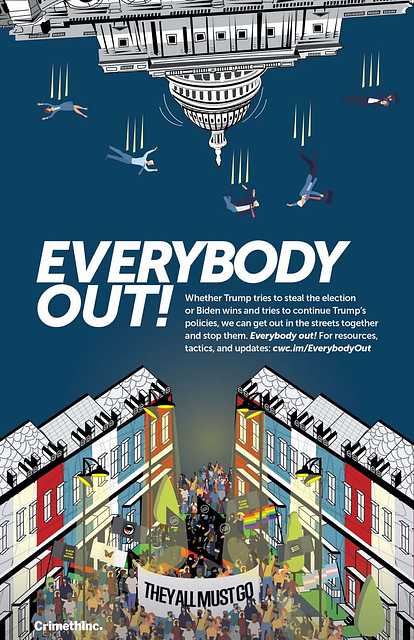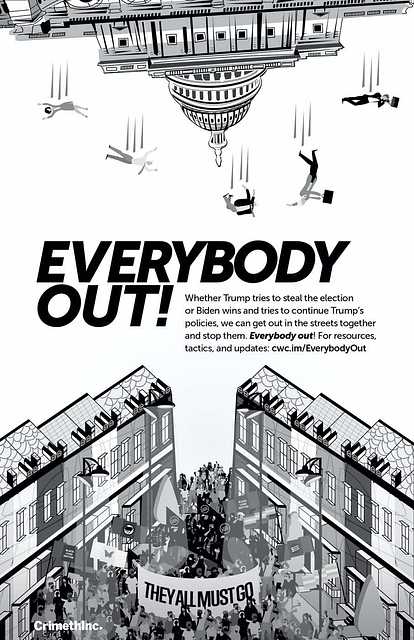Whether Trump tries to steal the election or Biden wins and tries to continue the same policies, we can come together to stop them. Here, we offer a selection of resources to prepare for post-electoral unrest, including posters, primers on protest and security skills, and information about what different groups are organizing around the country. Everybody out!

If Donald Trump leaves power in January, the credit will not be due to Joe Biden, nor simply to those who voted in the election, but to the social movements that have demonstrated that the United States will be ungovernable under four more years of Trump. Whether or not Trump leaves power, we cannot count on any government or political party to look out for us—we have to do that ourselves.
If protesters had not filled the streets, if anti-fascists had not shut down the white supremacists who were trying to build a movement to silence Trump’s opposition, if angry and heartbroken people had not forced the issues of police killings and detentions and deportations to the forefront of public discourse, the ruling class would probably have thrown all its weight behind supporting Trump’s presidency, giving him the money and support he needed to hold on to power regardless of how unpopular he is. Only our resistance has set a limit to what he can do; the rulings from judges and pushback from local politicians came after our mobilizations—and we can’t count on them, anyway, especially not as Trump continues to stack the judiciary. Trump is still trying to figure out how to hold on to power, but he is in a much weaker position than he would have been if people had stayed at home and waited for voting to take care of everything.
If Trump tries to hold on to power, it will be up to us to stop him—regardless of what disinformation appears in the media, regardless of Democrats’ intentions to cede power to him once again. That could mean mass protests like the ones that took place in Portland over the summer when Trump sent in federal forces in an unsuccessful attempt to suppress dissent. It could mean coordinated disruptions. Rather than focusing on symbolic marches and displays, go where your actions will be most effective in exerting economic pressure. Be careful not to present a vulnerable target to far-right attackers.
Some people have been speaking about the possibility of a general strike. In 2020, when the market already treats most of us as expendable, a general strike has to look very different than the strikes of a hundred years ago. If the idea is to carry out a general strike, refusing to show up to work is not enough—we have to intervene to interrupt the functioning of the economy itself. Identify infrastructure and activities that are essential to the circulation of commodities, the accumulation of profit, and the maintenance of control. Study previous efforts to interrupt them, such as the November 2, 2011 general strike in Oakland at the height of the Occupy Movement and the port blockades that accompanied it.
It’s important to understand in advance that if there is going to be a movement powerful enough have an impact, it will not be the property of any particular organizing group, nor will it be limited to any particular strategy or code of conduct. It will have to draw together all the different participants in all the existing movements—against police violence, against prisons and deportation, against colonialism and ecological destruction and capitalism and war—along with all the tactics and perceptions they have developed throughout years of experience. It will have to be diverse and inclusive—a movement in which many movements fit.
Everybody out means this is not just about Trump or “preserving democracy.” If Biden wins the election, we must not permit his administration to continue Trump’s policies, we must continue to fight against every imposition on anyone’s liberty or well-being. A Biden victory is not the end of this struggle; it is just the beginning of a new chapter. If Biden becomes president, on January 20, we should mobilize at ICE detention facilities and police stations and prisons to show that our opposition to all of these racist and oppressive institutions will continue until they are abolished.
Everybody out means we don’t trust any politician to control our future. It means we won’t legitimize institutions that have never looked out for us or kept us safe. It means coming together to determine together what our lives should be, ourselves, directly.
Resources
Trump’s term is ending as it began, with a likelihood of street conflict. The following guides offer a great deal of information about how to participate in effective protests while protecting yourself and your community.
Getting Connected
- How to Form an Affinity Group
- Find a Local Mutual Aid Network
- Where to Find Your Local Medic Collective—This is not comprehensive, but offers a good starting point.
Security Culture
- What Is Security Culture?
- Bounty Hunters and Child Predators: Inside the FBI Entrapment Strategy
- When the Police Knock on Your Door—Your rights and options: a legal guide
- If the FBI Approaches You to Become an Informant—An FAQ
You can find a lot of important information about general security in protest situations here.
Digital Security
- Your Phone Is a Cop—An OpSec/InfoSec primer for the dystopian present.
- Burner Phone Best Practices—A user’s guide
- Doxcare—Prevention and aftercare for those targeted by doxxing and political harassment
This thread spells out how to protect your privacy via proper phone safety at demonstrations—before, during, and after the protest.
Dressing for Success and Security
- Fashion Tips for the Brave
- The Femme’s Guide to Riot Fashion—This season’s hottest looks for the discerning femme.
- Staying Safe in the Streets
- Blocs, Black and Otherwise
Safety Gear
- A Demonstrator’s Guide to Helmets
- A Demonstrator’s Guide to Gas Masks and Goggles—Everything you need to know to protect your eyes and lungs from gas and projectiles.
You can read some more tips about protest gear from protesters in Hong Kong here.
Strategy, Planning, and Tactics
- A Step-by-Step Guide to Direct Action—What It Is, What It’s Good for, How It Works
- Tools and Tactics in the Portland Protests—This text offers an overview of a wide range of options from leaf blowers and umbrellas to shields and lasers.
- Creative Direct Action Visuals—Making banners and more.
- Blockade Tactics—courtesy of the Ruckus Society
- Tips about Blockading—from Beautiful Trouble
- Lock Boxes—How to blockade with
Jail Support
- Jail Support
- Jail Support form from Rosehip Collective—Fill this out in advance of any event at which you might be arrested and leave it with your attorney or a support contact.
- NLG National Support Hotlines and Other Resources
When Things Go Badly
- Making the Best of Mass Arrests
- How to Survive a Felony Trial—Keeping your head up through the worst of it
- I Was a J20 Street Medic and Defendant—How we survived the first J20 trial and what we learned along the way.
Basic First Aid in the Streets
- First Aid for Protestors
- Eye safety at protests—You can read more on how to do an eye flush here
- How to Protect Yourself from Audio Attacks—LRAD, sirens, etc.
- COVID-19 Safety at Protests
You can obtain more graphics on this subject here.
For Experienced Medics
- Protocols for Common Injuries from Police Weapons—For street medics and medical professionals treating demonstrators.
- A Demonstrator’s Guide to Responding to Gunshot Wounds—It can also be useful to read these accounts from people who have experienced gunfire at demonstrations.
These four zines from the Rosehip Medic Collective include a range of useful information.
This collection of resources that appeared shortly before Trump took office includes more topical material, addressing non-violence, solidarity, white supremacy, colonialism, patriarchy, capitalism, and more.


